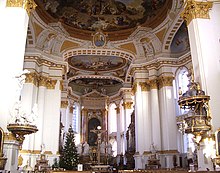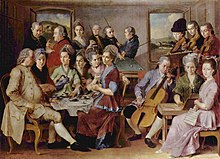Januarius Zick


Johann Rasso Januarius Zick (born February 6, 1730 in Munich , † November 14, 1797 in Ehrenbreitstein ) was a German painter and architect at the time when the late Baroque was replaced by early classicism .
Life
Januarius Zick learned his craft as a fresco painter from his father Johannes Zick . When he was fourteen, his eleven-year-old brother fell from the scaffolding while doing unskilled labor at Weingarten Abbey and died. 1745–1748 Januarius completed an apprenticeship as a bricklayer with Jakob Emele in Schussenried . He then worked together with his father, first in the Würzburg residence and until the mid-1750s on the frescoes in the residence in Bruchsal .
In 1756 Zick went to Paris for further training , where he established relationships with the art world in Rome, Basel and Augsburg. In 1757 the picture Jean-Jacques Rousseau finds the answer to the award task of the Academy of Dijon ( Museum zu Allerheiligen , Schaffhausen).
After the frescoing of Engers Castle near Neuwied in 1760, Zick was appointed court painter to the Electorate of Trier . He settled in Ehrenbreitstein, where he married the landlord's daughter Anna Maria Gruber (1745-1811). From 1774 he designed inlaid pictures for the cabinet maker David Roentgen .
From the late 1770s onwards, the artist carried out important fresco commissions and altarpieces in Upper Swabian monastery and parish churches. In the mid-1780s he moved to the Kurtrier and Kurmainzer area.
One of his fourteen children was the portrait and landscape painter Konrad Zick .
Works (selection)

- 1757: Self-portrait ( Museum for Franconia , Würzburg)
- 1757: Jean-Jacques Rousseau finds the answer to the award task of the Academy of Dijon, oil on copper (Museum zu Allerheiligen, Schaffhausen)
- 1760: Frescoes in Engers Castle
- 1766: Painting of the side altars in the transept of the Church of St. Theodor and Alexander of the Ottobeuren monastery
- before 1769: Painting of the high altar and the side altars in the chapel of the Princess Franziska Christine Foundation in Essen-Steele
- 1770–1780: Luna and Endymion, oil on canvas ( Austrian Gallery Belvedere , Vienna)
- 1771: Hüttenherr Gottfried Peter de Requilé ( Rheinisches Landesmuseum Bonn )
- 1776: Remy family ( Germanisches Nationalmuseum Nürnberg )
- 1777: Mercury in the sculptor's workshop ( Middle Rhine Museum Koblenz )
- 1778–1783: worked as a painter and interior designer for the church of the Benedictine monastery in Wiblingen , completion of the new building begun by Johann Georg Specht
- 1780: Inauguration of the Golden Church, oil on canvas ( Prüm Abbey )
- 1780: frescoes in the parish church of Zell (Riedlingen)
- 1782: Dürrenwaldstetten parish church
- 1782/83: Ceiling frescoes in the church of the Benedictine monastery of St. Peter and Paul in Oberelchingen near Ulm
- 1784: Ceiling fresco of twelve-year-old Jesus in the temple in the church of the Premonstratensian monastery of St. Verena, red on red
- 1785: Fresco in the electoral palace in Koblenz
- 1786: Sankt Ignaz and Dompropstei in Mainz as well as the church of the Augustinian monastery in Triefenstein
- 1787: Academy hall of the Electoral Palace in Mainz
- 1790: Altar sheet in the Hofkirche in Koblenz
- 1791: Reconciliation of the Sabines and Romans ( Ulmer Museum )
- 1792/93: Palais Schweitzer in Frankfurt am Main
- (before?) 1791: Painting of the main altar of the parish church of St. John the Baptist in Schwerzen
gallery
Church art
Whitsun miracle , 1780 (parish church Zell, Riedlingen )
Ascension Day , 1780 (parish church Zell, Riedlingen)
Jesus in the Temple , 1784 (Parish Church St. Verena, Rot an der Rot )
Assumption of Mary , 1784 (Parish Church of St. Verena, Rot an der Rot)
Secular art
Night watch, around 1770 ( Rheinisches Landesmuseum Bonn )
Mercury in the sculptor's workshop, 1777 ( Middle Rhine Museum Koblenz )
Reconciliation of the Sabines and Romans, 1791 ( Ulmer Museum )
Varia

The modern plaque opposite claims that Januarius Zick was born in Lachen (Swabia) in 1727 like his father Johannes instead of 1730 in Munich . This is probably due to a mistake with an older brother, who was also baptized with the name Januarius but had already died as an infant.
literature
- JB Schmid: Zick, Januarius . In: Allgemeine Deutsche Biographie (ADB). Volume 45, Duncker & Humblot, Leipzig 1900, p. 150 f.
- Kurt Eitelbach: The Zick family of painters. Works from Koblenz private collection . Middle Rhine Museum, Koblenz 1976
- Harriet Brinkmöller-Gandlau: ZICK, artist family. In: Biographisch-Bibliographisches Kirchenlexikon (BBKL). Volume 14, Bautz, Herzberg 1998, ISBN 3-88309-073-5 , Sp. 437-441.
- Othmar Metzger: Januarius Zick. Dated and datable paintings . Deutscher Kunstverlag, Munich 1981, ISBN 3-422-00733-4
- Adelheid Simon, Franz X. Schlagberger: Januarius Zick (1730–1797). The last major bourgeois painter in Germany. Frescoes, drafts, panel paintings . Auxilium, Prüm approx. 1987, ISBN 3-924634-02-5
- (Chronicle of) the parish of St. John the Baptist Schwerzen, 1992
- Michael Roth, Josef Strasser (Red.): Januarius Zick and his work in Upper Swabia . Exhibition of the Ulm Museum. Klinkhardt and Biermann, Munich 1993, ISBN 3-7814-0343-2
- Josef Straßer: Januarius Zick 1730–1797. Paintings, graphics, frescoes . Konrad, Weißenhorn 1994, ISBN 3-87437-318-5 (also dissertation from the University of Munich, 1989)
- Andrea Wandschneider (Ed.): Januarius Zick. Paintings and drawings . Exhibition of the municipal gallery in the riding hall, Paderborn. H-und-S-Verlag, Paderborn 2001, ISBN 3-929507-11-0
- Jens Fachbach: Januarius Zick (1730–1797) "whose skill and fame is already widespread in Germany through his excellent Mahlereyen frescoes made in several churches in Swabia and various palaces" , in: Matthias von der Bank (ed.): Das Inheritance of the fathers. With the Zick family of painters through two centuries (= exhibition catalog Mittelrhein-Museum Koblenz), Petersberg 2018, pp. 41–46.
Web links
- Literature by and about Januarius Zick in the catalog of the German National Library
- Works by Januarius Zick at Zeno.org .
- Article in the portal Rheinische Geschichte
Individual evidence
- ↑ Jens Fachbach, Januarius Zick (see literature), p. 41.
| personal data | |
|---|---|
| SURNAME | Zick, Januarius |
| ALTERNATIVE NAMES | Zick, Johann Rasso Januarius (full name) |
| BRIEF DESCRIPTION | German painter and baroque architect |
| DATE OF BIRTH | February 6, 1730 |
| PLACE OF BIRTH | Munich |
| DATE OF DEATH | November 14, 1797 |
| Place of death | Koblenz-Ehrenbreitstein |








